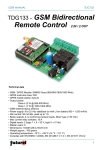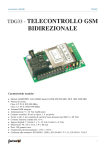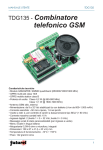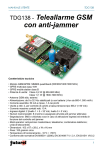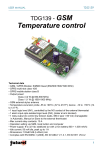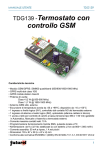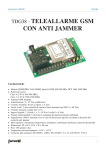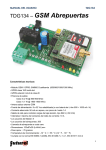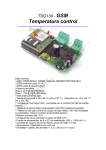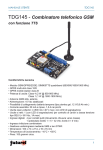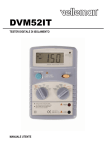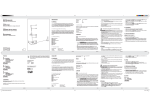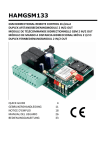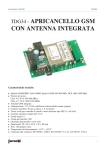Download TDG140 - GSM Remote Control with DTMF
Transcript
USER MANUAL TDG140 TDG140 - GSM Remote Control with DTMF Technical data • GSM / GPRS Module: SIM900 Quad (850/900/1800/1900 MHz) • GPRS multi-slot class 10/8 • GPRS mobile station class B • Output power: Class 4 (2 W @ 850-900 MHz) Class 1 (1 W @ 1800-1900 MHz) • GSM external stylus antenna • Power supply: 9 to 32 Vdc stabilized (or with Li-Ion battery 800 ÷ 1,000 mA/h) • Idle current: 50 mA idle, peak up to 1 A • Relay outputs: 2, to control low tension loads, SELV type (< 60 Vdc) • Max current relay contacts: 10 A • Digital inputs: 2 (logic 1 = 5 ÷ 32 V; logic 0 = 0 V) • Dimensions: 103x67x28 (LxWxH) mm • Operating temperature: -10°C ÷ +55°C (14 °F - 131 °F) • Weight approx.: 100 grams • Complies with EN 60950-1 (2006), EN 301489-7 V.1.3.1, EN 301511 V9.0.2 1 TDG140 USER MANUAL TABLE OF CONTENTS 1. Important information ............................................................................................. 3 2. Safety instructions................................................................................................... 3 3. General information................................................................................................. 4 4. Operating conditions............................................................................................... 4 5. Proper use............................................................................................................... 5 6. Description.............................................................................................................. 5 7. Connectors and LEDs............................................................................................. 6 8. Installing the USB.................................................................................................... 7 9. Start-up.................................................................................................................... 7 10 Configuration........................................................................................................... 7 11. Configuration SMS................................................................................................... 8 12. Table of command and configuration SMS............................................................ 17 13. DTMF Commands................................................................................................. 18 14. Managing the device through a computer ............................................................ 21 15. Troubleshooting..................................................................................................... 27 2 USER MANUAL TDG140 1. Important information Please, carefully read the information in this manual before attempting to operate the device in order to protect yourself and use the equipment properly. This device shall be exclusively utilized for its intended use. In no event shall the company Futura Elettronica, or its dealers, be held responsible for any damage, either extraordinary, incidental or indirect of any nature (financial, physical, etc.), arising from the possession, use or failure of this product. In case of changes to the device, tampering, or non-compliance with the instructions in this manual the warranty will be null and void. The device contains highly integrated components that can be damaged by electrostatic discharge. Therefore, do not touch any metal part (tracks, component terminals, etc.) with your hands. Only handle the device by the edges in order to avoid touching the components on the board. Notice The user who makes the module operational by adding further components or by putting it into a housing is seen as a manufacturer and is obliged to hand out all the necessary technical documentation as well as place his name and address on the device. Products made with this equipment have to be considered as industrial products from the safety perspective. The phone costs related to sending SMS generated by the device are charged on the SIM in the device. 2. Safety instructions In accordance with the current regulations on safety, whenever using a device under tension all necessary precautions shall be taken. The device must always be installed in absence of tension. •The device must be placed into a suitable housing before use. During the installation, the device must not be connected to the power source or to other devices. • Before handling the device or opening the container where it has been placed, unplug the power connector and make sure the circuit is not live. •Before working with any kind of tool on the device make sure it is disconnected from the power supply and that components that store energy (capacitors) are discharged. •All cables connected to the device, particularly the power supply ones, have to be checked regularly for fractures or damage of the isolation shield. If cables are visibly damaged, the device has to be switched off immediately until they have been replaced. • Strictly comply with the technical specifications of components or modules used with this device. If the information contained herein and/or the information on the components or modules used with the device are not clear enough, please contact a qualified technician. 3 TDG140 USER MANUAL • Before starting the device, carefully check whether it is suitable for the intended field of application. In case of doubt, please contact a qualified technician or the Manufacturer / Dealer. • The Manufacturer / Dealer cannot be held responsible for improper handling or wrong connections, therefore it cannot be held responsible for any damage that may result. • Devices that operate with <35 Volts must be connected by a qualified technician. • Before starting the device check there is no current leakage in the housing. 3. General information For EU residents Environmental information related to this product This symbol on the device or package indicates it is forbidden to dispose of the product in the environment at the end of its lifecycle as it could be harmful for the environment itself. Do not dispose of the product (or batteries, if used) as unsorted waste. For more information about the recycling of this product, please contact the city hall, your local waste disposal service, or the shop where it was purchased. 4. Operating conditions Warning: before making connections to the device, carefully verify that the supply tension and the tension applied to the relay contacts correspond to those described in this manual! Important information: • The device must be installed in compliance with the current safety standards. • Supply the remote TDG140 only with stabilized DC tension between 9 and 32 V, to be applied to the power plug (see Picture 1) keeping in mind the polarity (center positive). Use a safety current-limited power supply providing current of at least 1 A. The power cable must not exceed 3 meters. • The relay outputs in the device can only be used to control low tension loads SELV type (<60 Vdc). •The tension applied to the contacts of each relay must not exceed 60 V. • The switching current on the relays must not exceed 10 A*. •The maximum tension applied to the digital inputs is 32 Vdc. • The device can work in any position. 4 USER MANUAL TDG140 • Check that the section of the cables used is enough. • The operating temperature of the device ranges between -10 °C and +55 °C (14 °F – 131 °F). • If moisture condensation occurs, wait for at least 2 hours before starting the equipment. • Keep the device away from flower vases, sinks, water pipes, etc. • The container used to house the device must have adequate ventilation holes. • Protect the device from moisture, spray water and heat. • The device is meant for operation in clean and dry rooms. • Do not expose the device to heavy vibrations. • Do not use the device in presence of flammable gases, vapors or dust. • The device can only be repaired by a qualified technician. • When repairing the unit, original parts must be used. The use of differing spare parts can cause serious material loss or personal injury. *the tracks connecting the relay contacts to the terminal are sized considering a load activation which absorbs 10 A. for short periods of time. 5. Proper use This device is designed for the remote switching of electric and electronic units via the GSM network and for the remote retrieval of status information of its inputs by means of SMS messages automatically generated after those inputs change status. A different use is not allowed. 6. Description The TDG140 is a bidirectional remote control module easy to install and simple to use. With the TDG140 it is possible to remotely control two relays (in monostable or bistable mode) by means of special SMS commands (with a password) or by means of DTMF tones sent from any mobile phone. it is possible to store up to 8 telephone numbers to which the device sends SMS and phone calls when (according to the settings made during the configuration) it considers the inputs active. Apart from the TDG140, you will need a valid SIM Card from any network provider (GSM 900 / 1800 MHz). When using a prepaid SIM Card always check the available 5 TDG140 USER MANUAL credit so that in case of alarm a SMS can be sent. Typical fields of application regard the control of power loads, switching on and off alarm devices, the reception, via SMS, of information concerning the state of door sensors, movement sensors, level sensors, etc.) 7. Connectors and LEDs As shown in picture 1. the TDG140 remote control has a terminal for connection with different external units. Pairs IN1 and IN2 are two opto-isolated inputs, while the other two pairs (OUT1 and OUT2) correspond to the NC, NO and C contacts of the two relays. Connect the supply tension of the device, between 9 and 32 Vdc, to the outlet marked PWR (center positive). Via USB (optional) directly installed on the card you can connect a computer, with the special “TDG Configurator” software it is possible to make all programming and function setting or change the list of authorized users. Power supply connector PWR (center positive) USB interface (optional) SIM card slot SMA female connector for GSM antenna Picture 1 LD1 C NO NC NC NO C OUT 1 OUT 2 + - IN 1 + LD2 LD3 LD4 LD5 - IN 2 When the device is engaged in the GSM network research the “LD5” LED flashes at 1 Hz frequency; when it is hooked in the network, it will flash briefly every two seconds; the LED is on only when the module receives a call. “LD1” and “LD2” indicate the status of the relays; “LD3” and “LD4” indicate the status of the inputs. LD1 on = Relay 1 active 6 USER MANUAL TDG140 LD2 on = Relay 2 active LD3 on = IN1 active (logical condition set reached) LD4 on = IN2 active (logical condition set reached) LD3 and LD4 also report SMS reception (both of them flash for a few seconds), CALL reception (both LEDs on) and CONFIGURATION CALL on hold (both LEDs turn on alternatively after start-up and without phone numbers stored in the list). 8. Installing the USB A special USB interface (code FT782M), available separately, must be installed on the remote control card as shown in the picture alongside, the mini USB connector must be upwards. 9. Start-up You must first obtain a valid SIM Card from a GSM network provider. Use a common mobile phone to disable the SIM Card PIN. To do so, check the manual of the mobile. If the SIM Card PIN is not disabled, the device cannot work as it cannot connect to the GSM network. Before feeding the TDG140, please insert the SIM Card into the SIM Card holder (mind the orientation), making sure it is correctly blocked, the connect cable of the antenna to the connector. Now connect the power supply. 10. Configuration The device can be set as follows: - EASY SETUP (Configuration through call) - PROFESSIONAL SETUP (Configuration through SMS) - COMPUTER SETUP (Configuration through PC connection: it needs a USB interface, code FT782M, available separately) 1) EASY SETUP (Configuration through call made on start-up) When the device is supplied with power, “LD5” will immediately flash at 1 Hz frequency. The TDG140 will try to connect to the GSM network; when connected, “LD5” will briefly flash every two seconds or so. After the system initialization (which may take several seconds). the device alternately illuminates the yellow LEDs “LD3” and “LD4” to indicate the “configuration call” on hold, which should take place within 3 minutes. If during this time the unit receives a call, it stores the caller’s number (to which reply SMS will be sent) in the first memory location, it turns the two LEDs off and becomes operative; otherwise, at the end of the interval, it switches off the yellow LEDs and waits for the configuration SMS (“PROFESSIONAL SETUP” mode). 7 TDG140 USER MANUAL 2) PROFESSIONAL SETUP (Configuration through SMS executable at any time) This mode takes full advantage of the device with operations as both outputs switch, inclusion of additional phone numbers to manage the device, reception of alarm messages, change of SMS text generated by the TDG140, change output activation timing, and, in general, set the TDG140 with all parameters via simple SMS. A full reset to restore the defaults settings can also be made via SMS. The syntax for all available commands can be found in Section 11 (Configuration SMS). 3) COMPUTER SETUP (Configuration through PC connection: This mode easily allows you to set up the TDG140 – with no additional cost – through a computer (with a special software) connected via USB code FT782M (optional). Chapter 14 provides all necessary information to make the best use of this configuration mode. Configuration through call Turn on the device, wait till the yellow LEDs “LD3 e LD4” start to flash alternately; then, with the mobile used to control the TDG140 call the phone number corresponding to the SIM Card in the remote control. The device will reject the call and store the caller number in the first memory location. “LD3” and “LD4” will flash rapidly to indicate the operation. Check that the mobile used for the configuration has an active ID, i.e. the “hidden call” or “private call” has not been enabled. To return to the standard c configuration with active ID, please refer to the mobile instruction’s manual. To check your own mobile configuration simply call another mobile: The caller ID is active if it displays the number or name of the calling mobile. NOTE: Yellow LEDs “LD3” and “LD4” lighten up alternately until the TDG133 is set up with a call within the first three minutes of start-up. If time is up and no configuration has been made, the TDG133 turns off the two LEDs and waits for the configuration SMS. The EASY SETUP mode can be restored by disconnecting and reconnecting the power supply: you will have three minutes to set up the device. 11. Configuration SMS Commands and settings can be sent from any mobile via SMS as long as the message includes the password (essential to ensure the setting cannot be made by outsiders). To speed up certain commands, it is possible for the device to store 8 numbers enabled to send commands without the password. The numbers in the list are the same to which (if enabled) a few rings or alarm messages will be sent. However, there is a series of “sensitive” functions, that no matter who sends the SMS, require a password: in particular, functions that add or remove other numbers from the list, that change the current password, or request the list of approved numbers. As a result of a command or query, the device replies with an execution confirmation SMS or a SMS with information about the settings. 8 USER MANUAL TDG140 Please note that all commands that do not require a password are effective only if they come from a recognized phone, that is a phone which number is in the list of those stored in the remote; an outsider needs a password. The remote accepts multiple SMS, that is SMS with more than one command, in order to save money; commands must be separated by a comma. Of course, a multiple command will produce several answer messages, in order to disable this you can disable the reply by adding at the beginning of the multi command SMS the string RISP, (see the description of this command). The device can also be managed by means of DTMF commands send only during a telephone conversation with the module. Those commands can be send from any phone (if the DTMF management filter has been disabled) or only from a number in the list (if, instead, the filter is active). The user can decide whether the management of the device through DTMF tones needs the protection of a password, no matter if the calling number is already in the list. Here are four categories four commands that manage the outputs, the inputs, the communication and the setting of the device. Here we present and describe all commands that can be sent to de device via SMS. Note: Every command must be CAPITALIZED and written without spaces. -Command PWDxxxxx;pwd changes the password; xxxxx is the new password (numeric, five digits) and pwd is the current password (the default password is 12345). Example: 54321 as the new password and 12345 as the current password PWD54321;12345 Note: the password is required. -Command NUMx+39nnnnnnnnnnn;pwd stores a phone number (up to 8 numbers, 19 digits each) in the device; x is its position in the list; nnnnnnnnnn is the phone number with country code (+39 for Italy); pwd is the current password. Example: how to enter number 3498911512 in the 8th position NUM8+393498911512;12345 Note: the password is required only if you try to save the number in a position already occupied by another one, or when the command is sent from a phone that is not in the list. If the command is sent from an unknown phone, the password is always required. -Command NUMx;pwd removes a phone number from the list; x is its position in the list; pwd is the current password. Example: how to delete the 4th phone number from the stored list NUM8+393498911512;12345 Note: the password is required. - Command NUM?;pwd requests the list of phone numbers currently stored in the device; pwd is the current password. Example: 9 TDG140 USER MANUAL NUM?;12345 Note: The password is required. - Command RES;pwd resets the initial settings (default) of the system (also the stored phone numbers are deleted); pwd is the current password. Example: RES;12345 Note: The password is required. The remote can send SMS to the phones of the people that must be advised of a change in the inputs status. The following commands enable or disable that function, (only valid for the numbers in the list): - Command SMSxxxxxxxx:ON allows the number in the specified position to receive SMS on input status; x is the position of the number(s) in the list. Example: How to allow phone numbers on positions 1 and 5 in the list to receive the SMS on input status SMS15:ON Note 1: The command will only modify memory position 1 and 5, and not the state of the other ones (2, 3, 4, 6, 7, 8); if the latter are already enabled to receive alarm SMS (for example because previously activated), they will continue receiving those messages. Note 2: The password is required. - Command SMSxxxxxxxx:OFF does not allows the number in the specified position to receive SMS on input status; x is the position of the number(s) in the list. Example: How not to allow phone numbers on positions 2 and 7 in the list to receive the SMS on input status SMS27:OFF Note 1: The command will only modify memory position 2 and , and not the state of the other ones (1, 3, 4, 5, 6, 8); if the latter are already enabled to receive alarm SMS (for example because previously activated), they will continue receiving those message. Note 2: The password is required. In addition to SMS, the device can also make short calls to ring the phones of the people (which number is in the list) that must be advised of a change of input status; the ringtone draws people’s attention faster than a SMS, which may arrive with some delay. -Command VOCxxxxxxxx:ON allows the number on the specified position to receive a ringtone on the inputs status; x is the position of the number(s) in the list. Example: How to allow phone numbers on positions 1 and 5 in the list to receive the ringtone on input status VOC15:ON Note 1: The command will only modify memory position 1 and 5, and not the state 10 USER MANUAL TDG140 of the other ones (2, 3, 4, 6, 7, 8); if the latter are already enabled to receive alarm ringtone (for example because previously enabled), they will continue receiving it. Note 2: The password is required. -Command VOCxxxxxxxx:OFF does not allow the number in the specified position to receive the ringtone on the input status; x is the position of the number(s) in the list. Example: How not to allow phone numbers on positions 2 and 4 in the list to receive the ringtone on input status VOC24:OFF Note 1: The command will only modify memory position 2 and 4, and not the state of the other ones (1, 3, 5, 6, 7, 8); if the latter are already enabled to receive alarm ringtone (for example because previously enabled), they will continue receiving it. Note 2: The password is required. By default, all phone numbers in the first eight positions of the list (provided they are stored) receive a notification of the input alarm via SMS or short call (ringtone). The same applies if the reset command which restores the initial settings is sent to the remote control. Commands regarding the setting of the level that defines the alarm condition are listed below: -Command LIVx:A sets a HIGH level as the alarm condition for inputs IN1 or IN2 (the input is in alarm under tension); x stands for input 1 or 2 . Example: How to set a HIGH level of alarm activation on input 2 LIV2:A -Command LIVx:B sets a LOW level as the alarm condition for inputs IN1 or IN2 (the input is in alarm in absence of tension); x stands for input 1 or 2 . Example: How to set a LOW level of alarm activation on input 2 LIV2:B -Command LIVx:V sets a level variation as the alarm condition for inputs IN1 or IN2 (the input is in alarm after going from a LOW level to a HIGH level, or the opposite); x stands for input 1 or 2 . Example: How to set a level variation as alarm activation on input 1 LIV1:V Please note that: By default, inputs are activated in presence of tension. - Command LIV? requests the alarm activation level regarding the inputs. Example: LIV? You can define a period of time (known as input inhibition time) following an alarm ac- 11 TDG140 USER MANUAL tivation, during this time the device does not control the level on a specific input; that period may be set between 0 and 59 prime minutes. The default value is 5 minutes. - Command INI1:mm sets the inhibition time on input 1; mm is the time in prime minutes. - Command INI2:mm sets the inhibition time on input 2; mm is the time in prime minutes. Example: How to establish that, following an alarm, IN1 cannot determine other alarms for two minutes INI1:02 -Command INI? requests the current inhibition time setting regarding the inputs. Example: INI? When it is necessary to control sensors that monitor frequently variable phenomena and to receive real notifications about the current events, it might be necessary to ignore the inhibition time. The remote can temporarily disable, input by input, the preset inhibition time with the following commands: - Command TIZ1x resets the inhibition time if input 1 is idle; x is the setting parameter (if = 0 no reset, if = 1 reset). Example: How to reset inhibition time on input 1 TIZ11 Example: How to disable the inhibition time reset function on input 1 TIZ10 - Command TIZ2x resets the inhibition time if input 2 is idle; x is the setting parameter (if = 0 no reset, if = 1 reset). Example: How to reset inhibition time on input 2 TIZ21 Example: How to disable the inhibition time reset function on input 2 TIZ20 Note 1: The default setting for this function is 0. To request the status of the reset function use command INI? Note 2: The inhibition time is reset when, following an alarm, the input is back to idle within a shorter time than the interval of inhibition, restore will take place at the next input activation. The device lets you define how long the alarm condition must be for a certain input so that the circuit sends the notifications. The setting is made through the following messages: - Command OSS1:ss defines the length of the observation time regarding input 1; ss is the time in seconds. 12 USER MANUAL TDG140 Example: How to set a ten-second observation time for input 1 OSS1:10 - Command OSS2:ss defines the length of the observation time regarding input 2; ss is the time in seconds. Example: how to set a 59-second observation time for input 2 OSS2:59 Note: The observation time can be set between 1 and 59 seconds. The default value for both inputs is 1 second. - Command OSS? requests the current observation time setting regarding the inputs. Example: OSS? Regarding the inputs activity, it is possible to define, for each of them, the notification message about presence of tension , as well as for the one for absence of tension: -Command TIN1A:xxxx defines the message the device sends to the numbers in the list enabled to receive alarm SMS when input 1 gets the alert of tension presence; xxxx is the message you want to write (100 characters max. including spaces). The text message does not accept the semi colon (;) and all letters must be capitalized. The default message is: ALARM!! INPUT 1 HIGH. Example: How to set the alarm text “TENSION ON INPUT 1” for input 1 in presence of tension TIN1A: TENSION ON INPUT 1 -Command TIN1B:xxxx defines the message the device sends to the numbers in the list enabled to receive alarm SMS when input 1 gets the alert of tension absence; xxxx is the message you want to write (100 characters max. including spaces). The text message does not accept the semi colon (;) and all letters must be capitalized. The default message is: ALARM!! INPUT 1 LOW. Example: How to set the alarm text “NO TENSION ON INPUT 1” for input 1 in absence of tension TIN1B:NO TENSION ON INPUT1 -Command TIN2A:xxxx defines the message the device sends to the numbers in the list enabled to receive alarm SMS when input 2 gets the alert of tension presence; xxxx is the message you want to write (100 characters max. including spaces). The text message does not accept the semi colon (;) and all letters must be capitalized. The default message is: ALARM!! INPUT 2 HIGH. Example: How to set the alarm text “TENSION ON INPUT 2” for input 2 in presence 13 TDG140 USER MANUAL of tension TIN2A:TENSION ON INPUT2 -Command TIN2B:xxxx defines the message the device sends to the numbers in the list enabled to receive alarm SMS when input 2 gets the alert of tension absence; xxxx is the message you want to write (100 characters max. including spaces). The text message does not accept the semi colon (;) and all letters must be capitalized. The default message is: ALARM!! INPUT 2 LOW. Example: How to set the alarm text “NO TENSION ON INPUT 2” for input 2 in absence of tension TIN2B:NO TENSION ON INPUT2 Note: Keep in mind that messages will be sent from the remote control according to the settings made in relation to the logic level intended as an alarm. The operation mode, the timing, and the status requests of the input relays can be managed by SMS: - Command OUTx:ON activates the specified output relay; x is the output relay 1 or 2. Example: How to activate output relay 1 OUT1:ON Example: How to activate output relay 2 OUT2:ON - Command OUTx:OFF disables the specified output relay; x is the output relay 1 or 2. Example: How to disable output relay 1 OUT1:OFF Example: How to disable output relay 2 OUT2:OFF - Command STA? requests the condition of the remote outputs. Example: STA? - Command OUTx:ss inverts the condition of the specified relay for the desired time; x is output relay 1 or 2; ss is a period between 1 and 59 seconds. Example: How to disable output relay 1 (if already active) or how to activate it (if not active) for 10 seconds OUT1:10 - In case of black-out, command RIPx stores the relay status and restores it when power is back on; x has a value of 1 to enable restoring, 0 to disable it. The default value is 1. Example: How to enable the relay status recovery on start-up RIP1 Example: How to disable the relay status recovery on start-up 14 USER MANUAL TDG140 RIP0 - Command RIP? requests the current setting for relay status recovery. Example: RIP? The remote gives the possibility to send a customizable SMS to the phone number on the first position in the list whenever it is fed: - Command AVVx enables o disables the afore mentioned function; x has a value of 1 to enable it, 0 to disable it. The default value is 0. Example: How to enable the function to send a start-up SMS AVV1 Example: How to disable the function to send a start-up SMS AVV0 - Command TSU:xxxxxxxxxxxx sets the text of the message the remote sends during start-up; xxxxxxxxxxx is the message (100 characters max. including spaces). The text message does not accept the semi colon (;) and all letters must be capitalized. The default phrase is: SYSTEM STARTUP. Example: How to set the start-up message “TDG140 DEVICE ON” TSU:DEVICE TDG140 ON The following are the 5 SMS commands regarding the interaction with the DTMF commands: - Command FILx enables or disables the filter on incoming calls; x has a value of 1 to prevent access to the numbers not in the list, 0 to allow the remote to answer calls coming from any phone number. The default value is 1. Example: how to enable the filter on incoming calls FIL1 - Command SICx sets the module so that, after answering the incoming calls, requests the access password to the DTMF command; x has a value of 0 for free access to the command, 1 if, instead, once the reply from the remote is obtained, the DTMF command can be performed only by those people who have the password. The default value is 0. He following commands (that can be sent from a phone number in the list) regard the definition of monostable activation time that extends the state inversion intervals in the impulsive command over the 9 seconds that can be set with the phone keypad. - Command TIM1:xx extends the state intervention interval in the impulsive command of relay 1; xx is the time in seconds between 00 and 59. 15 TDG140 USER MANUAL Example: how to set a 15-second activation time for relay 1 TIM1:10 - Command TIM2:xx extends the state intervention interval in the impulsive command of relay 2; xx is the time in seconds between 00 and 59. Example: how to set a 25-second activation time for relay 2 TIM2:25 Note: he default value is 5 seconds. Always on outputs, there is a command that shows the current set time for monostable mode without calling the remote and making a query from the DTMF. - Command TIM? lets you know the current set time for monostable mode for both relays. Example: TIM? As already mentioned at the beginning of Chapter 11, the system accepts messages with multiple commands separated by a comma, helping the user save time and money. There follows that the system replies to certain commands with more than one SMS. This can be avoided by means of a command placed at the beginning of the SMS sent to the TDG140. - Command RISP at the beginning of a multiple message disables all reply messages. Example: how to disable the answer message related to the sent commands RISP,OUT1: ON,LIV1:A, INI1:10 16 USER MANUAL TDG140 12. Table of command and configuration SMS FUNCTION SMS COMMAND DEFAULT VALUE PWD REQUIRED 12345 PASSWORD REPLACEMENT PWDxxxxx;12345 STORE NUMBERS (max. 8 numbers, max. 19 digits per number); x IS THE POSITION NUMx+393355760937;12345 - DELETE A NUMBER NUMx;12345 - YES ONLY IF POSITION X IS NOT FREE YES CHECK STORED NUMBERS NUM?;12345 - YES FULL RESET RES - YES SET NUMBERS THAT WILL RECEIVE SMS SMSxxxxxxxx:ON ALL YES SET NUMBERS THAT WILL RECEIVE RINGTONES VOCxxxxxxxx:OFF ALL YES LOGIC LEVEL HIGH ALARM (INPUT UNDER TENSION); x can represent 1 or 2. LIVx:A ACTIVE UNDER TENSION - LOGIC LEVEL LOW ALARM (NO TENSION IN INPUT ); x can represent 1 or 2. LIVx:B ACTIVE IF NO TENSION - LOGIC LEVEL ALARM VARIATION LIVx:V ACTIVE UNDER TENSION - LEVEL REQUEST LIV? - - INHIBITION TIME INPUT 1 (00 to 59 min) INI1:mm 5 MINUTES - INHIBITION TIME INPUT 2 (00 TO 59 MIN) INI2:mm 5 MINUTES - QUERY TO INHIBITION TIME INI? - - RESETS INHIBITION TIME IF INPUT 1 IS BACK TO IDLE x=0: DOES NOT RESET x=1: RESETS TIZ1x 0 - RESETS INHIBITION TIME IF INPUT 2 IS BACK TO IDLE x=0: DOES NOT RESET x=1: RESETS TIZ2x 0 - OBSERVATION TIME INPUT1 (00÷59 s) OSS1:ss 1 - OBSERVATION TIME INPUT2 (00÷59 s) OSS2:ss 1 - OBSERVATION TIME REQUEST OSS? - - RELAY ACTIVATION IN BISTABLE MODE OUTx:ON - - RELAY DEACTIVATION IN BISTABLE MODE OUTx:OFF - - CHANGE OF MONOSTABLE RELAY STATE (01-59 seconds) OUTx:ss - - RELAY RESET x is 1 to obtain reset, 0 to avoid resetting RIPx 1 - RESET QUERY RIP? - - (continues on next page) 17 TDG140 USER MANUAL Continuation of “Table of command and configuration SMS” FUNCTION SMS COMMAND DEFAULT VALUE PWD REQUIRED INPUT AND OUTPUT STATUS REQUEST STA? - - SEND SMS ON START-UP: x has a value of 1 for activation and 0 for deactivation AVVx 0 - ALARM TEXT INPUT 1 IF UNDER TENSION (max. 100 characters) TIN1A:xxxxxxxxxxx ALARM 1 HIGH. ALARM TEXT INPUT 1 IF NO TENSION (max. 100 characters) TIN1B:xxxxxxxxxxx ALARM 1 LOW. ALARM TEXT INPUT 2 IF UNDER TENSION (max. 100 characters) TIN2A:xxxxxxxxxxx ALARM 2 HIGH. ALARM TEXT INPUT 2 IF NO TENSION (max. 100 characters) TIN2B:xxxxxxxxxxx ALARM 2 LOW. START-UP MESSAGE TEXT (max. 100 characters, send only to first stored number) TSU:xxxxxxxxxxx RELAY 1 ACTIVATION TIME ON DTMF COMMAND (00÷59 s) TIM1:xx 5 SECONDS - RELAY 2 ACTIVATION TIME ON DTMF COMMAND (00÷59 s) TIM2:xx 5 SECONDS - ACTIVATION RELAY TIME REQUEST TIM? - - SICx 0 - FILx 1 - DISABLE REPLY FOR THAT MULTIPLE MESSAGE RISP - - EASY SETUP None voice call within three minutes of start-up. DTMF PASSWORD REQUEST x=0: REQUEST DISABLED x=1: REQUEST ENABLED CALLS FILTER FOR DTMF MANAGEMENT x=0: FILTER DISABLED x=1: FILTER ENABLED SYSTEM STARTUP MULTIPLE MESSAGES NOT ALLOWED MULTIPLE MESSAGES NOT ALLOWED MULTIPLE MESSAGES NOT ALLOWED MULTIPLE MESSAGES NOT ALLOWED MULTIPLE MESSAGES NOT ALLOWED 13. DTMF Commands Unlike SMS commands, that can be sent any time, DTMF commands can only be sent during a “phone conversation” with the module, that means only after calling the remote SIM number and after the device replies. The reply lies in three consecutive beeps when the password is requested, and only one in case the password is not required. These commands are divided into four categories: output management, input management, communication management and setting. The next two commands regard the bistable mode of the relay. 18 USER MANUAL TDG140 - Button 1 changes the status of relay RL1, which is to activate it if it was at rest or to disable it if, before the command, it was excited. - Button 2 changes the status of relay RL2, which is to activate it if it was at rest or to disable it if, before the command, it was excited. The remote control replies to both commands by means of: - 1 beep to indicate the relay, after the command, is active. - 2 beep to indicate the relay, after the command, is off. Relays can be set to operate in a pulsed manner, i.e. you can send the order to provisionally invert its condition with the time set by means of the command TIMx:tt (see Table of command and configuration SMS - Button 3 allows to control the temporary inversion of RL1. - Button 4 allows to control the temporary inversion of RL2. The remote control replies to both commands by means of: - 1 beep to indicate the relay has been temporarily activated; - 2 beeps to indicate the relay has been put to rest. It is also possible to know the inputs current state using the keypad. - Button 5 is used to request the status of relay RL1. - Button 6 is used to request the status of relay RL2. The remote control replies to both commands by means of: - 1beep to indicate the relay is active. - 2 beeps to indicate the relay has been put to rest. The following two commands are used to manage the inputs: - Button 7 is used to request the status of input IN1. - Button 8 is used to request the status of input IN2. The remote control replies to both commands by means of: - 1 beep to indicate the corresponding optocoupler is conductive (tension in the input). - 2 beeps to indicate the corresponding optocoupler is idle (no tension or insufficient tension). Any time, once the command is considered finished, you can order the remote to close the communication. - Button 0 is used to close the communication with the device. The remote control replies to both commands by means of: - 5 beeps to indicate the communication will be closed. 19 TDG140 USER MANUAL Table: DTMF commands (normal operation) FUNCTION COMMAND REPLY CHANGE STATUS RELAY 1 BISTABLE MODE 1 1 BEEP – RELAY ACTIVATED 2 BEEPS – RELAY DISABLED CHANGE STATUS RELAY 2 BISTABLE MODE 2 1 BEEP – RELAY ACTIVATED 2 BEEPS – RELAY DISABLED CHANGE STATUS RELAY 1 MONOSTABLE MODE 3 1 BEEP – RELAY ACTIVATED AFTER SWITCHING 2 BEEPS – RELAY DISABLED AFTER SWITCHING CHANGE STATUS RELAY 2 MONOSTABLE MODE 4 1 BEEP – RELAY ACTIVATED AFTER SWITCHING 2 BEEPS – RELAY DISABLED AFTER SWITCHING RELAY 1 STATUS REQUEST 5 1 BEEP – RELAY ACTIVATED 2 BEEPS – RELAY DISABLED RELAY 2 STATUS REQUEST 6 1 BEEP – RELAY ACTIVATED 2 BEEPS – RELAY DISABLED REQUEST INPUT 1 7 1 BEEP – INPUT UNDER TENSION 2 BEEPS – NO TENSION IN INPUT REQUEST INPUT 2 8 1 BEEP – INPUT UNDER TENSION 2 BEEPS – NO TENSION IN INPUT CLOSE COMMUNICATION 0 5 BEEPS START SETTING * 3 BEEPS – PASSWORD REQUEST 1 BEEP – THE SYSTEM HAS BEEN SET SO AS NOT TO REQUEST THE PASSWORD Note: in order to change, enable or disable the password, please refer to the table of Configuration SMS Programming the device by means of DTMF is started by turning on the correct mode during a communication session by sending a specific tone. A password id required, the password that must always be introduced from the keypad and must be equal to the one to send in SMS management mode (the default password is 12345). - Button * is used to access the setting mode. The remote control replies to that command by means of: - 3 beeps to indicate the password request. - 1 beep to indicate the system has been set so as not to request the password. Once the authentication is done, it is possible to set the activation time for the relay with the following commands: - Button 1 allows you to enter the “relay RL1 monostable mode time setting”. - Button 2 allows you to enter the “relay RL2 monostable mode time setting”. The remote control replies to that command by means of: - 2 beeps to indicate is waiting for a new value. 20 USER MANUAL TDG140 - 1 beep to indicate the acquisition of a new value. It is possible to set a value between 1 and 9 s with the correct buttons. - Buttons from 1 to 9 are used to set an activation time (in monostable mode) of the selected relay, between 1 and 9 seconds. The remote control replies to that command by means of: - 2 beeps to indicate is waiting for a new value. - 1 beep to indicate the acquisition of a new value. To go back to the normal mode it is necessary to send the following bi-tone. - Button # is used to exit the setting mode and go back to normal mode (DTMF command). The remote control replies to that command by means of: - 4 beeps to indicate the programming mode is over . Table: Programming DTMF commands FUNCTION ENTERING REPLY COMMAND REPLY RELAY 1 ACTIVATION TIME SETTING MONOSTABLE MODE 1 2 BEEPS – READY TO RECEIVE SETTING Pressing a button between 1 and 9 time is set in seconds REPLIES WITH 1 BEEP RELAY 2 ACTIVATION TIME SETTING MONOSTABLE MODE 2 2 BEEPS – CONFIRMS COMMAND Pressing a button between 1 and 9 time is set in seconds REPLIES WITH 1 BEEP EXIT SETTING * 4 BEEPS -- 14. Setting the device through a computer By means of a computer with a specific software and USB interface code FT82M (optional) installed directly on the board, it is possible to manage all programming and function settings as well as change the list of enabled users. This speeds up the initial settings and saves on the cost of SMS. After starting the software, verify that a communication speed of 9600 Baud (8,N,1) is set. 21 TDG140 Installing and using the software The software can be downloaded at www.futurashop.it from the page of the TDG140. In order to use the management software it is first necessary to install it. Launch the Setup files and follow the installation instructions as they appear. Once this is done, start the program. After this, the window “TDG Configurator” appears on the screen; through this window it is possible to modify all the settings of the device, add users, change the password, etc. It is an intuitive program and the graphic interface simplifies this procedure. So as to use the available commands supply and connect the TDG140 to the computer, then select the communication port “COM” (top left) created. If need be, with the “Update” button you can update the list related to the available ports in the computer.. Afterwards, press “Connect” to activate the connection and wait for the screen to update with all the data on the connected module. From now on, the TDG140 can be managed from your computer (PC mode is shown by “LD3” on). If the device was connected to the computer before the storage of the first master number, the message “Waiting for Call for Master Number Storage” will appear on the log window (down). In order to continue with the setting, make the call so as to store the number. The execution will be confirmed with a message on the log window. 22 USER MANUAL USER MANUAL TDG140 In the “Information” tab you can find the IMEI and the firmware version of the connected device. in order to modify the access password stored in the device, type in the fields “Old” and “New” the desired password, and press “Run”. To access the system and make all possible settings, please type the current password in the field “System password”, then press “Confirm”. If the device does not reply to the commands sent from the computer, make sure the password stored in the PC is the same as the one specified in the management program. Management of phone numbers enables to control the device is done through the folder “Telephone Numbers”. It is possible to store or delete enabled numbers and to request the full list (visible on the right of the window) of those numbers in the device. Every selected operation (“Store”, “Delete” or “Request Full List”) must be confirmed by pressing “Run”. 23 TDG140 The tab “Notices” is used to enable or disable numbers on specific positions in the list, enabled to receive alarm SMS or calls. The tab “Inputs” defines the activation logic (High, Low or Variation) of the two inputs and their time. The device can be asked to retrieve the currently set time by ticking on “Request Set Tim” and then clicking on “Run”, a window, as the one shown, with the requested information will open immediately. 24 USER MANUAL USER MANUAL TDG140 The tab “Outputs” is used to enable or disable the function “Restore Relay Status in absence of tension”, and directly manage the relay. Parameters related to DTMF management (relay activation time, DTMF Password request, enable / disable call filter) can be defined with the folder “DMTF”. 25 TDG140 The text of the notification SMS sent from the device after a variation in the inputs status or a black-out can be defined by the user through the window “SMS Text”. Pressing “Activate Extended Log” it is possible to visualize, in a specific window, all data in transit in the communication port. 26 USER MANUAL USER MANUAL TDG140 The software version can be seen pressing “?” on the menu bar. Important: - Management via SMS is disabled when the TDG140 is connected to the computer. 15. Troubleshooting The following table presents all possible solutions to some problems that may arise: Problem Possible reason Solution Green led LD5 is off No supply tension or inverted polarity Check power supply cable Green LED LD5 flashes cyclically at 1 Hz frequency No GSM network available or signal intensity not enough Change the position of the external antenna The device does not send a reply to the configuration SMS Reply to the message with Do not use the RISP command command RISP is disabled in the SMS or recharge the SIM or there is no credit in the Card SIM Card. During the first start-up LEDS LD1 and LD3 do not lighten alternatively The device has already been started Completely reset the device using the RES command The device does not react to the call from an enabled number The mobile used for the call has a hidden ID Enable the ID on outcoming calls The device cannot engage in the GSM network The PIN on the SIM Card Disable the PIN request from has not been disabled the SIM Card The information in this manual is subject to change without notice. Technical Assistance In case of technical problems or questions concerning the TDG140, a hotline is available. Mon and Wed 2 pm - 6 pm CET (Central Europe Time) Technical assistance +39 0331.245587 27 TDG140 USER MANUAL Complies with all applicable european directives. Produced and distributed by: FUTURA ELETTRONICA SRL Via Adige, 11 - 21013 Gallarate (VA) Tel. 0331-799775 Fax. 0331-792287 web site: www.futurashop.it technical Information: [email protected] Relase: 29/09/2010 28 V.I. 1.0 - V.F. 2.0





























